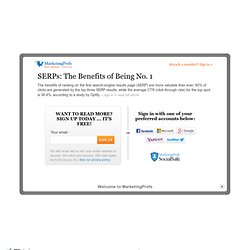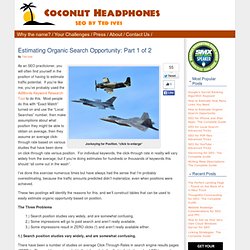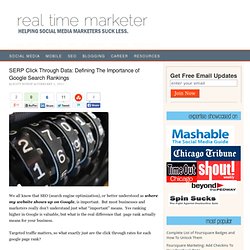

Are You Forgetting One of the Most Important Factors In Your Keyword Research? Note from Caleb: This is a guest post from Tom Ewer of Leaving Work Behind.

There are many mistakes you can make when conducting keyword research. You must be disciplined in your methods in order to avoid the potential hazards. Fortunately, there is a great deal of advice on the Internet regarding keyword research. If you read up on the subject and carry out your research in a considered and objective manner, you will have a good chance of avoiding disaster. Part 3: Where people are looking to find a local business. This time we look at where on the SERP (search result page) commands the most attention One of my favorite sources for SEO information, SEOmoz, recently posted their results of an eye-tracking study they did to show how consumers are trying to find local businesses.

I could just point a link to their post, which I’ll do here anyway, but I wanted to bring over their study and images because I have some additional points I wanted to make. Here’s their post. And here’s the Kat & Mouse take. Keyword query 1: “best pizza in Chicago” It’s clear in this screenshot, that the eyes follow the typical “F” path when viewing the page, i.e., start at the top, move to right, then go down the page, and move to the right less each time. Note that the #1 position is a purely organic listing. Takeaway 1: Do exceptional SEO on your website to get as close to the top as you can. Keyword query 2: “pizza” Search Engine Marketing - SERPs: The Benefits of Being No. 1.
The benefits of ranking on the first search-engine results page (SERP) are more valuable than ever: 60% of clicks are generated by the top three SERP results, while the average CTR (click-through rate) for the top spot is 36.4%, according to a study by Optify.

Not all CTRs are created equal, however. Although head, or high-volume, search terms, yield higher CTR for position No. 1 on the first SERP, low-volume, long-tail terms, generate better overall CTR on page one. Below, other findings from Optify's study, The Changing Face of SERPs: Organic Click Through Rate, based on analysis of organic keyword visits (Google US) gathered from Optify's software for a variety of B2B and B2C websites in December 2010. The CTR curve (chart below) supports the traditional understanding of SERPs: Ranking on the first page is far more valuable than ranking anywhere else. Estimating Organic Search Opportunity: Part 2 of 2. Cluck Cluck...I Hope the"Entrail" Reference is Just a Fowl Joke!

In Part 1, we came up with a standard decay curve by position that can be used to estimate Click-Through Rate, provided you know how many clicks are available. In this posting we’ll extend that to provide two ways of estimating organic search traffic potential, complete with a downloadable spreadsheet. Estimating Organic Search Opportunity: Part I. Jockeying for Position.

*click to enlarge* As an SEO practicioner, you will often find yourself in the position of having to estimate traffic potential. If you’re like me, you’ve probably used the AdWords Keyword Research Tool to do this. Most people do this with “Exact Match” turned on and use the “Local Searches” number, then make assumptions about what position they might be able to obtain on average, then they assume an average click-through rate based on various studies that have been done on click-through rate versus position. For individual keywords, the click-through rate in reality will vary widely from the average, but if you’re doing estimates for hundreds or thousands of keywords this should “all come out in the wash”. SERP Click Through Data: Defining Google Page Rank. We all know that SEO (search engine optimization), or better understood as where my website shows up on Google, is important.

But most businesses and marketers really don’t understand just what “important” means. Yes ranking higher in Google is valuable, but what is the real difference that page rank actually means for your business. Targeted traffic matters, so what exactly just are the click through rates for each google page rank? Having an understanding of what SERP (search engine page rank) click through averages are will help you to craft a better digital marketing strategy.
Having an understanding of your click through averages will help you to evaluate whether or not it’s worth the money and effort to try and take your page two ranking of a specific key word to a low page 1. The Value of Google Result Positioning. How much is the top spot on Google actually worth? According to data from the Chitika network, it’s worth a ton – double the traffic of the #2 spot, to be precise. In order to find out the value of SEO, we looked at a sample of traffic coming into our advertising network from Google and broke it down by Google results placement. The top spot drove 34.35% of all traffic in the sample, almost as much as the numbers 2 through 5 slots combined, and more than the numbers 5 through 20 (the end of page 2) put together. Google Organic SEO Click Through Rates. Ever since the famous AOL data leak of 2006 people have been endlessly quoting the same old figures when asked for amount of clicks a particular ranking gets.

Recently the data has become a lot more accurate thanks to the release of click data in Google Webmaster Tools and a new study by the Chitika ad network. From the AOL data we can see that first place gets 42% of traffic, compared to just 11.9% for second place. That seems too high to me. Next up we have a study by Neil Walker showing 46.37% for first and 29.43% for second – this is based on Webmaster Tools data across 2700 keywords. Finally we have the Chitika study which shows that first place gets 34.35% compared to 16.96% in second. Google Organic Click Through Rate (CTR) Top Google Ranking Captures 18.2% of Clicks [Study] A new study from Slingshot SEO re-examines the value of the top position in organic ranking.
![Top Google Ranking Captures 18.2% of Clicks [Study]](http://cdn.pearltrees.com/s/pic/th/google-ranking-captures-clicks-14376501)
Their estimates for the number one position are roughly half of figures provided by previous studies. This article examines potential reasons why. The Study and Methodology Slingshot SEO's organic CTR study, titled Mission ImposSERPble: Establishing Google Click-Through Rates, took place over the course of six months and examines 324 total keywords. Mission ImposSERPble: Establishing Click-through Rates. Google and its user experience is ever changing.

For a company that has more than 60% of the search market, it's common to hear the question, “How many visitors can we expect, if we rank [x]?” It’s a fair question. It's just impossible to predict. Which is a fair answer. But, as my father says, “If you want fair, go to the Puyallup.” To answer that question, we turned to major studies about click-through rates, incuding Optify, Enquiro, and the studies released using the leaked AOL data of 2006. Top Google Result Gets 36.4% of Clicks [Study] It’s critical for websites to appear on Page 1 of Google, especially in one of the top three organic positions, as these spots receive 58.4 percent of all clicks from users, according to a new study from Optify.
![Top Google Result Gets 36.4% of Clicks [Study]](http://cdn.pearltrees.com/s/pic/th/google-result-clicks-study-145833091)
Websites ranked number one received an average click-through rate (CTR) of 36.4 percent; number two had a CTR of 12.5 percent; and number three had a CTR of 9.5 percent. Being number one in Google, according to Optify, is the equivalent of all the traffic going to the sites appearing in the second through fifth positions.